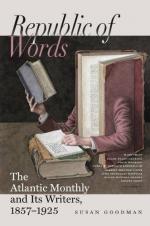But after all, Turner was one of the old school of artists. Claude was the first landscape painter of the line, Turner the last; subjective poets both,—the one a child, the other a mighty man. But the poets no longer govern the world as in times past; they give place to the philosophers. The race is no longer content with its inspirations and emotions, but must see and understand. The old school of Art was one of sentiment, the new is one of fact; and out of that English mind from whose seeming common-place level of untrained, unschooled intellect have burst so many of the loftiest souls the world has known,—from that mind more inspired in its want of academic greatness, more self-educated in its wild liberty, than the best-trained nations of Europe, this new school has fittingly had its origin.
We speak of it as a School, though yet in its rudiments, because it has a distinctive character, a real purpose,—and because it is the embodiment of the new-age spirit of truth-seeking, of the spirit of science, rather than that of song. Among the pictures contributed to the English exhibition by the Pre-Raphaelites, there are very few which do not convey the distinct impression of a determined effort to realize certain truths. There are few which succeed entirely; but this is so far from astonishing, that we have only to think that the oldest of these artists has hardly passed his first decade of recognized artistic existence, and that their aims are new in Art, to wonder that so much of fresh and subtile truth is given. There are two respects in which nearly all the works of the school agree, and which have come to be regarded by superficial students of Art as its characteristics, namely, that they are very deficient in drawing and devoid of grace. Both deficiencies are such as might have been expected from the circumstances. Young men filled with earnestness and enthusiasm, and with an artistic purpose full in view, will spend little time in acquiring academic excellences, or trouble themselves much with methods or styles of drawing. They dash at once to their purpose, and let technical excellence follow, as it ought, in the train of the idea of their work. Of course they do not compare, as draughtsmen and technists, with men who have spent years in getting a knowledge of the proportions of the human figure, and the best methods of applying color; but, on the other hand, they are safe from that most alluring and fatal course of study which makes the subject only a lay figure to display artistic capacity on. Of all the pictures of the school, in the collection of which we speak, there is but one of academic excellence in drawing,—the “King Lear” of Ford Madox Brown. All the others have errors, and some of them to a ludicrous degree; but wherever refined drawing is needed to convey the idea of the picture, no school can furnish drawing more subtile and expressive. The head of the “Light of the World” is worthy in this respect to be placed beside Raphael and Da




